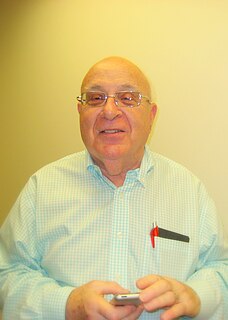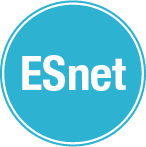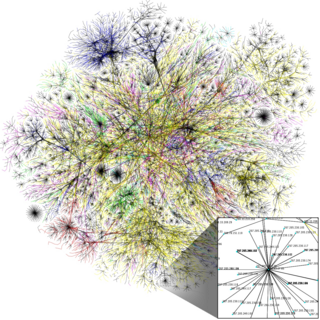
Packet switching is a method of grouping data that is transmitted over a digital network into packets. Packets are made of a header and a payload. Data in the header are used by networking hardware to direct the packet to its destination where the payload is extracted and used by application software. Packet switching is the primary basis for data communications in computer networks worldwide.
The National Science Foundation Network (NSFNET) was a program of coordinated, evolving projects sponsored by the National Science Foundation (NSF) beginning in 1985 to promote advanced research and education networking in the United States. NSFNET was also the name given to several nationwide backbone computer networks that were constructed to support NSF's networking initiatives from 1985 to 1995. Initially created to link researchers to the nation's NSF-funded supercomputing centers, through further public funding and private industry partnerships it developed into a major part of the Internet backbone.

The Advanced Research Projects Agency Network (ARPANET) was an early packet-switching network and the first network to implement the TCP/IP protocol suite. Both technologies became the technical foundation of the Internet. The ARPANET was initially founded by the Advanced Research Projects Agency (ARPA) of the United States Department of Defense.
CARNET is the national research and education network of Croatia. It is funded from the government budget and it operates from offices in Zagreb and five other cities.

David J. Farber is a professor of computer science, noted for his major contributions to programming languages and computer networking. He is currently the Distinguished Professor and Co-Director of Cyber Civilization Research Center at Keio University in Japan.

The Greek Research and Technology Network or GRNET is the national research and education network of Greece. GRNET S.A. provides Internet connectivity, high-quality e-Infrastructures and advanced services to the Greek Educational, Academic and Research community, aiming at minimizing the digital divide and at ensuring equal participation of its members in the global Society of Knowledge. Additionally, GRNET develops digital applications that ensure resource optimization for the Greek State, modernize public functional structures and procedures, and introduce new models of cooperation between public bodies, research and education communities, citizens and businesses. GRnet's executives have been contributors of or occupied board positions in organisations including GÉANT, TERENA, DANTE,GR-IX, Euro-IX,, RIPE NCC. GRNET provides advanced services to the following sectors: Education, Research, Health, Culture. GRNET supports all Universities, Technological Education Institutes, Research Centers and over 9,500 schools via the Greek School Network a population of more than one million people. Video presentations of some of the services are available in Pyxida.

The Energy Sciences Network (ESnet) is a high-speed computer network serving United States Department of Energy (DOE) scientists and their collaborators worldwide. It is managed by staff at the Lawrence Berkeley National Laboratory.

Prime College is an information technology, management, and science college in Nayabazar (Khusibu) Kathmandu, Nepal, established in 2001. The college offers courses for BBA, BIM, BBS B.Sc (CSIT) and CCNA.

CESNET is developer and operator of national e-infrastructure for science, research, development and education in Czech Republic. The CESNET association was founded in 1996 by Czech public universities and the Academy of Sciences of the Czech Republic. An important part of CESNET's activities is research of advanced network technologies and applications from hybrid networking, programmable hardware, metacomputing to middleware and video transmissions. CESNET fulfils the role of NREN within the Czech Republic and represents it in international organisations such as the GÉANT Association, EGI and GLIF. CESNET is involved in the implementation of the European backbone network project called GÉANT. Within the Czech Republic CESNET fulfils the role of a coordinator of large infrastructures involved in the field of information technology.

The High Performance Computing Act of 1991 (HPCA) is an Act of Congress promulgated in the 102nd United States Congress as on December 9, 1991. Often referred to as the Gore Bill, it was created and introduced by then Senator Al Gore, and led to the development of the National Information Infrastructure and the funding of the National Research and Education Network (NREN).

CANARIE manages and develops components of digital research infrastructure for Canada's research, education and innovation communities. The organisation receives the majority of its funding from the Government of Canada. It operates the national backbone network of Canada's National Research and Education Network (NREN), supports the development of research software tools; provides cloud resources for startups and small businesses; provides access and identity management services; and supports the development of policies, infrastructure and tools for research data management.

The Kiwi Advanced Research and Education Network (KAREN), now known simply as the REANNZ Network, is a high-capacity, ultra high-speed national research and education network (NREN) connecting New Zealand's tertiary institutions, research organisations, libraries, schools and museums, and the rest of the world. REANNZ , a Crown-owned not-for-profit company, owns and operates KAREN.

The University Computing Centre in Zagreb has a long tradition in the area of information and communication technologies. It was founded in 1971 within the University of Zagreb, the only Croatian university at the time, with the purpose to enhance the implementation of information technologies in the academic community as well as in Croatia in general.

Al Gore is a former US Senator who served as the Vice President of the United States from 1993 to 2001. In the 1980s and 1990s, he promoted legislation that funded an expansion of the ARPANET, allowing greater public access, and helping to develop the Internet.
Stephen Wolff is one of the many fathers of the Internet. He is mainly credited with turning the Internet from a government project into something that proved to have scholarly and commercial interest for the rest of the world. Dr. Wolff realized before most the potential in the Internet and began selling the idea that the Internet could have a profound effect on both the commercial and academic world.
The Academic Scientific Research Computer Network of Armenia (ASNET-AM) is the national research and education network (NREN) of Armenia. ASNET-AM was created in 1994. The structure and policy of ASNET-AM operation was developed and realized by the Institute for Informatics and Automation Problems of the National Academy of Sciences of Armenia.

The Networking and Information Technology Research and Development (NITRD) program consists of a group of U.S. federal agencies to research and develop information technology (IT) capabilities to empower Federal missions; support U.S. science, engineering, and technology leadership; and bolster U.S. economic competitiveness.

The Research and Educational Networking Association of Moldova (RENAM) is the national research and education networking organisation (NREN) of Moldova. RENAM was incorporated in June 1999 as an association under Moldovan law. It is a member of TERENA.

AMRES is the National Research and Education Networking organisation (NREN) in Serbia. After it was founded on 22 April 2010 as an institution by the Serbian government, AMRES took over the responsibility for the academic network and the associated services from the Computer Centre of the University of Belgrade. AMRES represents Serbia in international forums such as TERENA, but the University of Belgrade is still the organisation representing Serbia in the project that provides the funding for the European backbone network GÉANT.

















